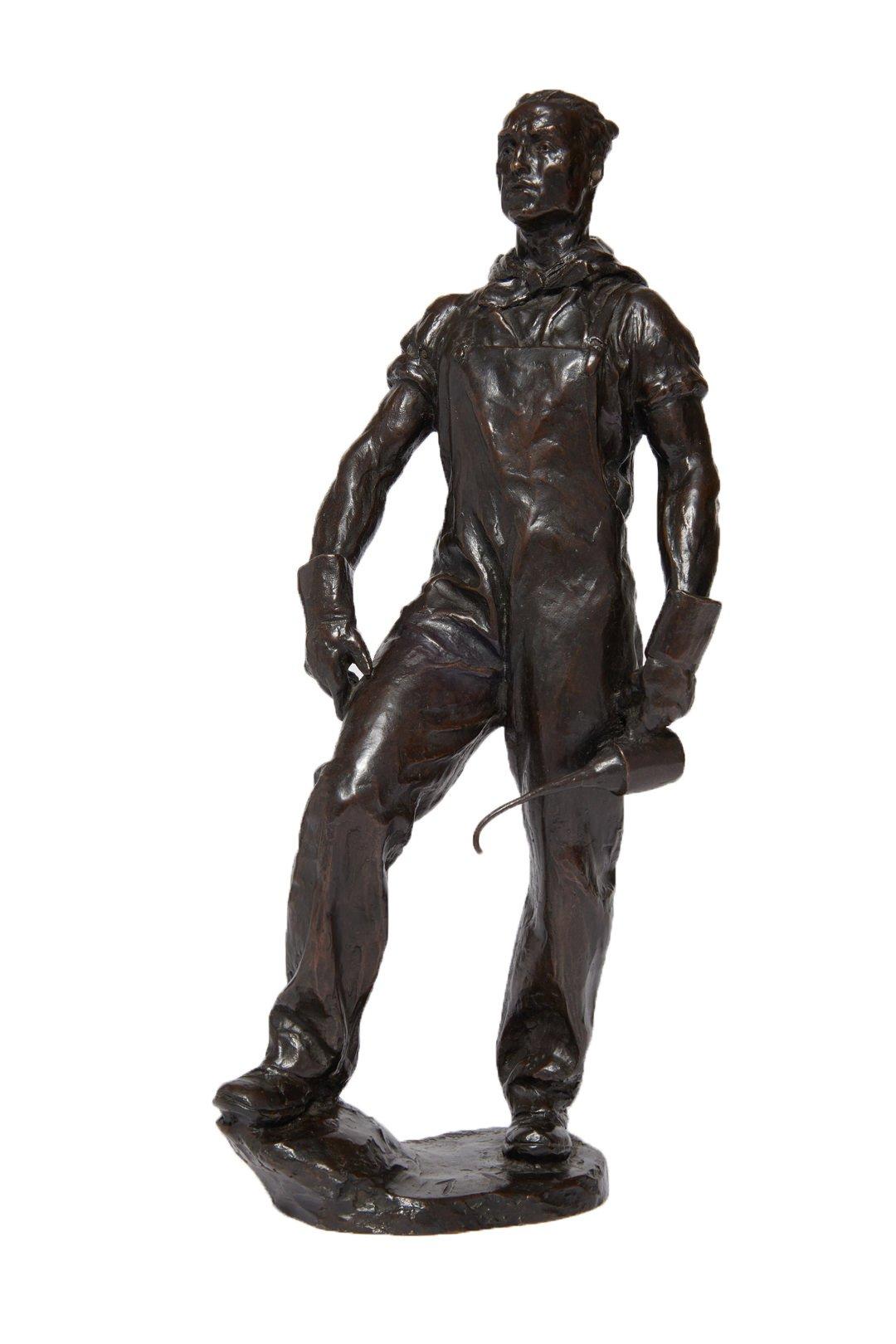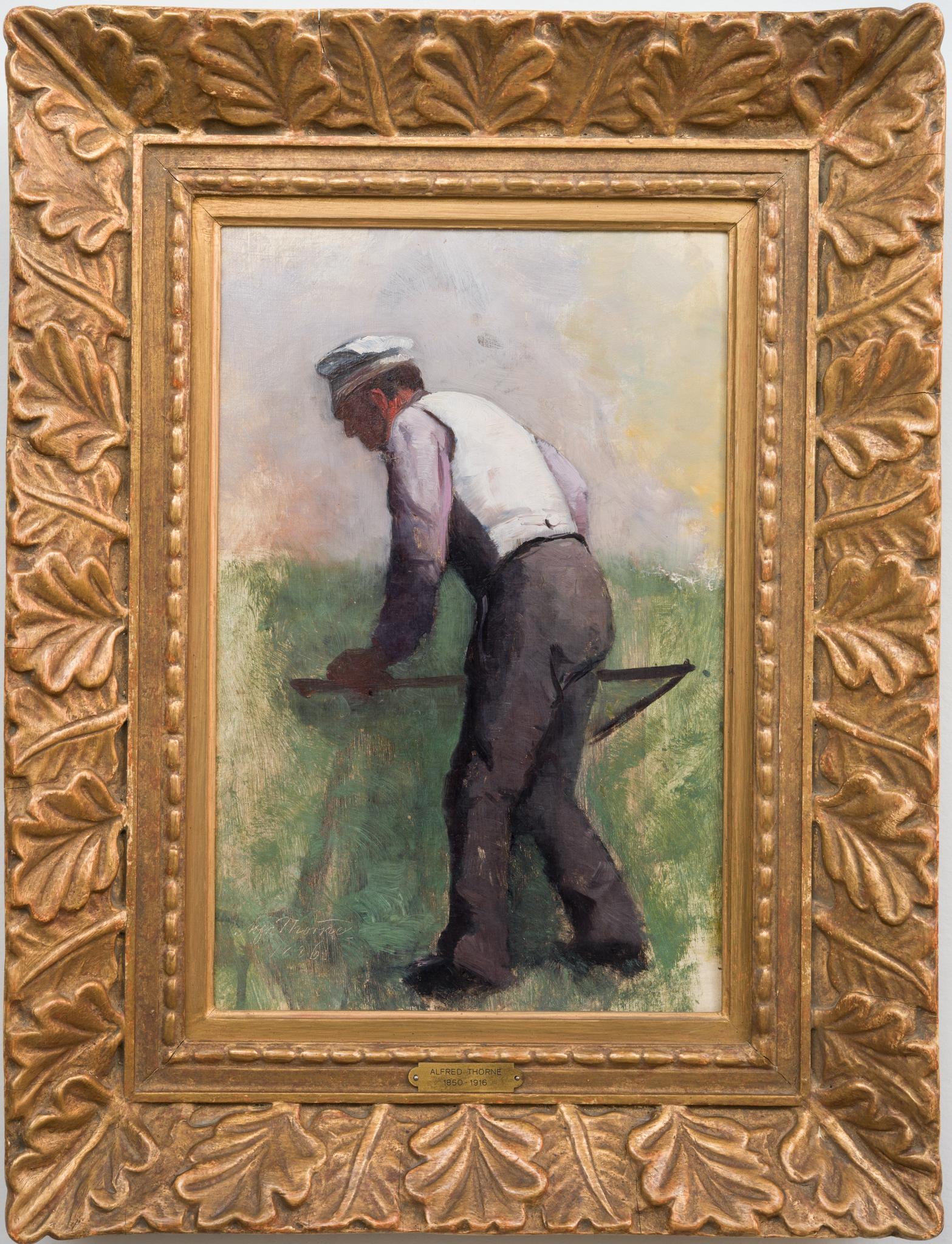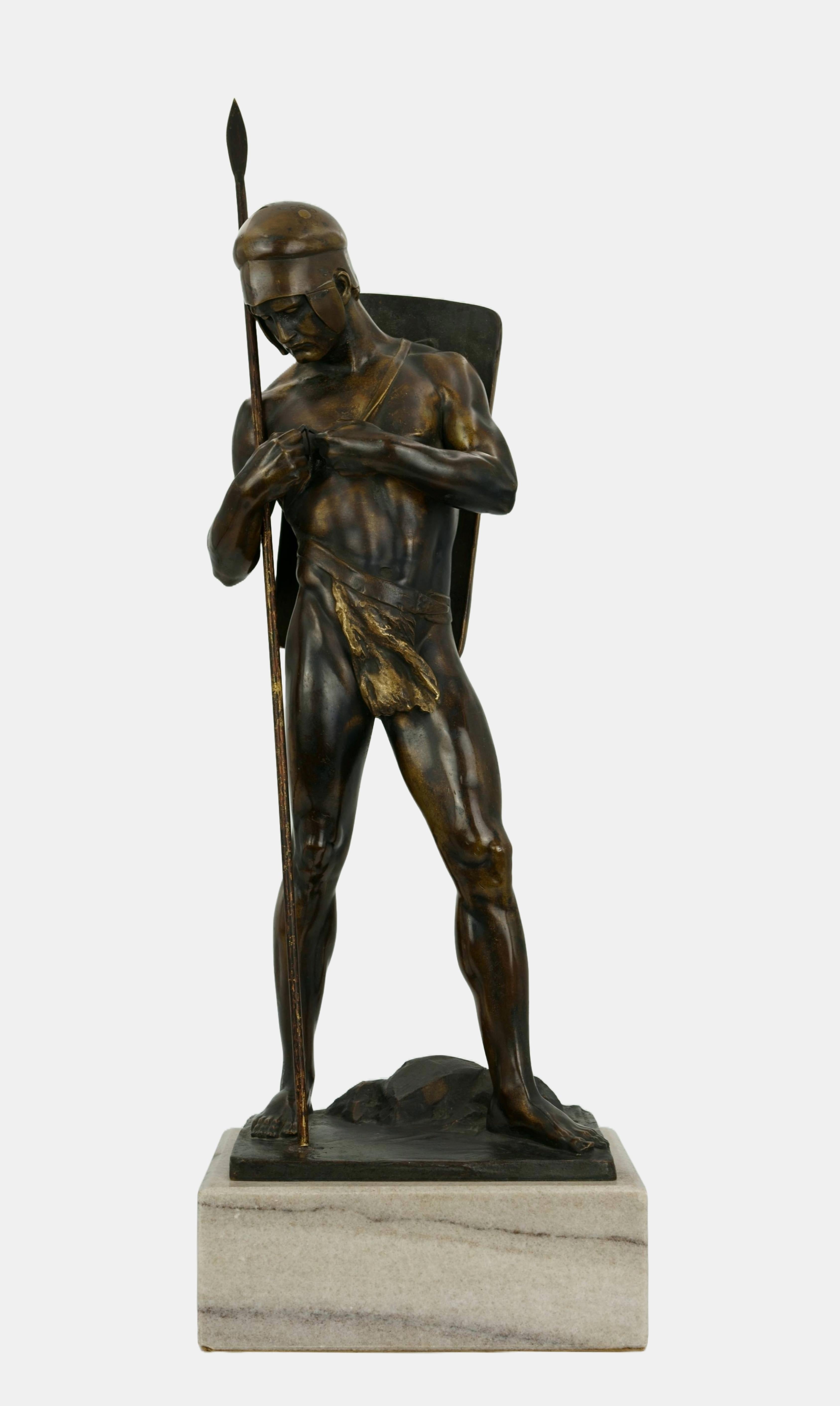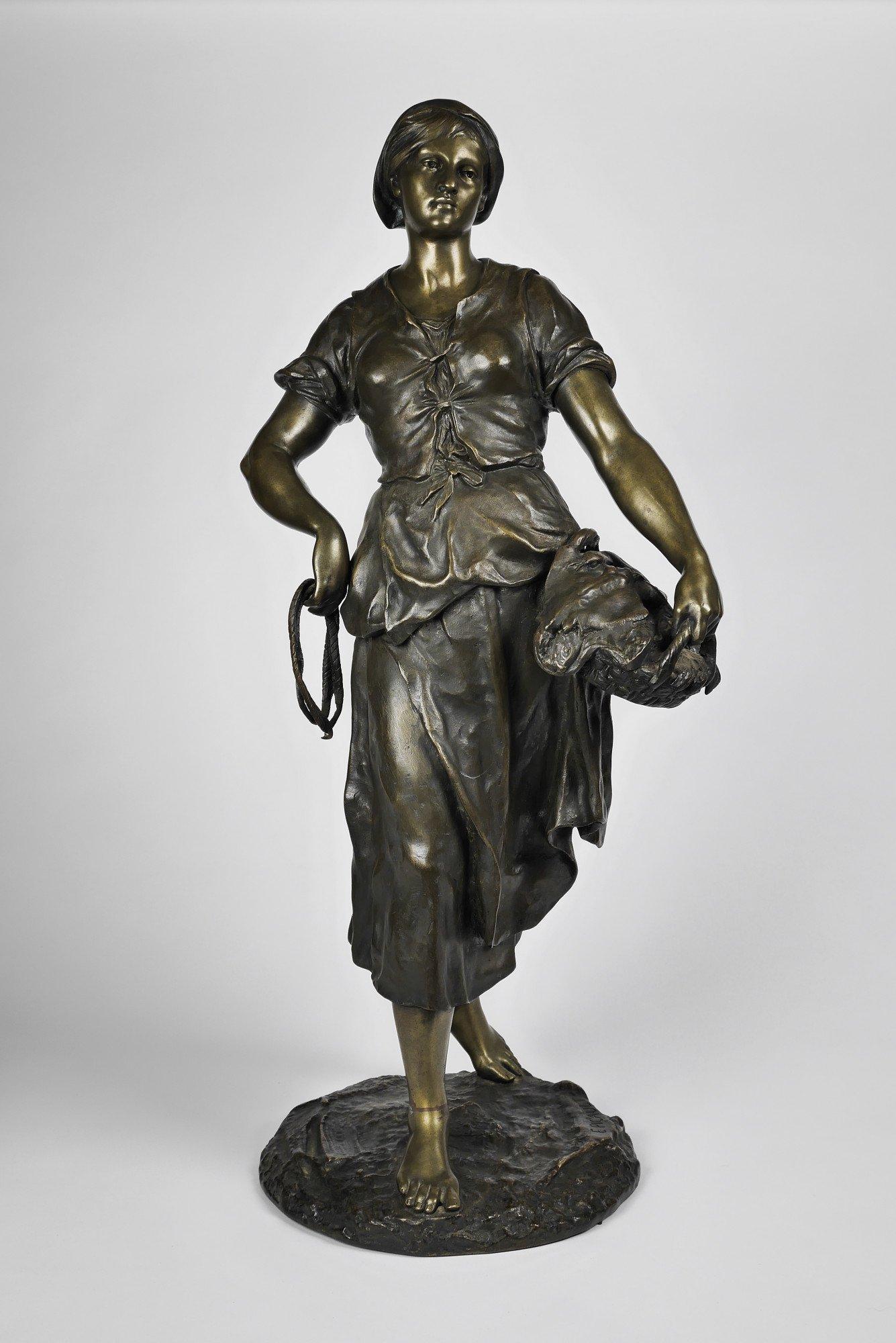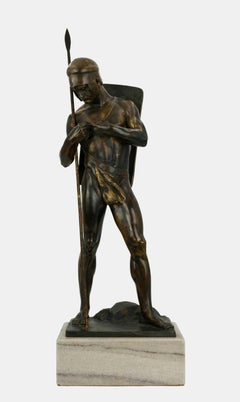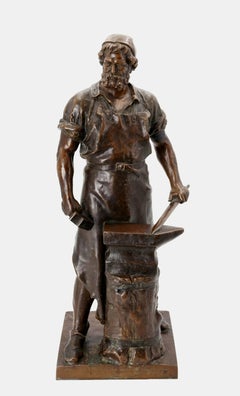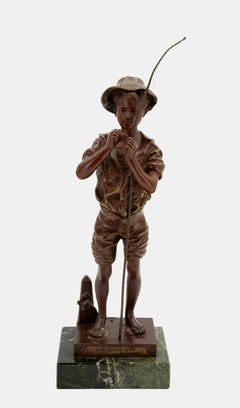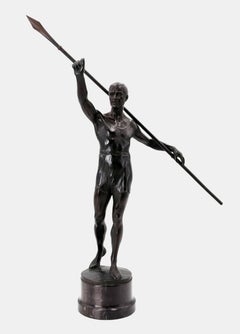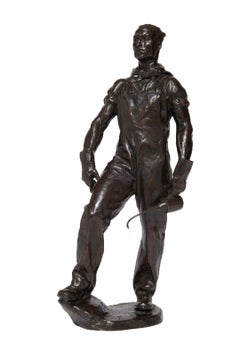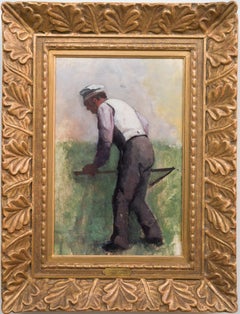Items Similar to Field worker with rake / - The Humility of the Farm Worker -
Want more images or videos?
Request additional images or videos from the seller
1 of 10
Paul Ludwig KowalczewskiField worker with rake / - The Humility of the Farm Worker -c. 1900
c. 1900
$1,503.99
$1,879.9820% Off
£1,147.99
£1,434.9920% Off
€1,280
€1,60020% Off
CA$2,121.45
CA$2,651.8120% Off
A$2,330.32
A$2,912.9020% Off
CHF 1,217.84
CHF 1,522.3020% Off
MX$27,790.96
MX$34,738.7020% Off
NOK 15,421.12
NOK 19,276.4020% Off
SEK 14,366.08
SEK 17,957.6020% Off
DKK 9,756.06
DKK 12,195.0720% Off
About the Item
Paul Ludwig Kowalczewski (1865 Mieltschin - 1910 Berlin), Field worker with rake, around 1900. Brown and brown-greenish patinated bronze with cast naturalistic plinth mounted on a white veined marble base (10 cm high), total height 50 cm. Dimensions of the bronze: 40 cm (height), x 16 cm (width) x 13 cm (depth), weight 10.8 kg. Signed “P.[aul] L.[udwig] Kowalczewski.” on the plinth and also with the abbreviation “fc. [fecit]” as the work of the artist.
- Slightly rubbed and minimally stained in places, overall in excellent condition for its age
- The Humility of the Farm Worker -
Paul Ludwig Kowalczewski, who himself grew up in a rural region of Poznan, elevated the field worker to an independent pictorial subject. However, not as a new hero of the time, as the metalworker in particular was portrayed as an agent of progress, but as a humble older man. Having finished his work, as indicated by the pedestal, the barefoot worker has taken off his hat to say a prayer bareheaded. He leans on his tool, a simple rake. Just as the Bible says after the expulsion from paradise, he has worked by the sweat of his brow throughout the advanced years of his life. A burden you can see on his hunched back.
He may have prayed the Lord's Prayer with his eyes half closed, reaching the line "Give us this day our daily bread". A thanksgiving for the daily bread, which the field worker helps to produce, and at the same time a plea for the nourishment of the soul, for man does not live by bread alone.
About the artist
Paul Ludwig Kowalczewski studied sculpture at the Berlin Academy of Arts from 1895 to 1898. From 1899 to 1906, the artist, who died at the age of 45, exhibited salon bronzes and life-size busts at the Great Berlin Art Exhibition. Kowalczewski was one of the first artists to depict workers and peasants in bronze.
GERMAN VERSION
Paul Ludwig Kowalczewski (1865 Mieltschin - 1910 Berlin), Feldarbeiter mit Rechen, um 1900. Braun und braun-grünlich patinierte Bronze mit gegossener naturalistischer Plinthe auf weißgeädertem Marmorsockel (10 cm Höhe) montiert, Gesamthöhe 50 cm. Maße der Bronze: 40 cm (Höhe), x 16 cm (Breite) x 13 cm (Tiefe), Gewicht 10,8 kg. Auf der Plinthe mit „P.[aul] L.[udwig] Kowalczewski.“ signiert und zudem mit dem Kürzel „fc. [fecit]“ als Werk des Künstlers ausgewiesen.
- vereinzelt leicht berieben und minimal fleckig, insgesamt in einem altersgemäß ausgezeichneten Zustand
- Die Demut des Landarbeiters -
Paul Ludwig Kowalczewski, selbst in einer ländlichen Region in Posen herangewachsen, erhebt den Feldarbeiter zum eigenständigen Bildsujet. Allerdings nicht als neuer Heros der Zeit, wie insbesondere der den Fortschritt voranbringende Metallarbeiter dargestellt wurde, sondern als demütigen älteren Mann. Nach getaner Arbeit, die von der Terrainplinthe angedeuteten wird, hat der barfüßige Feldarbeiter seinen Hut gezogen, um barhäuptig ein Gebet zu sprechen. Dabei stützt er sich auf sein Arbeitsgerät – einen einfachen Rechen. Ganz so, wie es in der Bibel nach der Vertreibung aus dem Paradies heißt hat er über die inzwischen fortgeschritten Lebensjahre hinweg im Schweiße seines Angesichts gearbeitet. Eine Last, die seinem gekrümmten Rücken abzulesen ist.
Er mag mit halb geschlossenen Augen in sich gesammelt das Vaterunser sprechen und bei der Zeile „Unser tägliches Brot gib uns heute“ angelangt sein. Ein Dank für das tägliche Brot, an dessen Herstellung der Feldarbeiter mitwirkt, und zugleich die Bitte um eine Speisung der Seele, da der Mensch nicht vom Brot allein lebt.
zum Künstler
Paul Ludwig Kowalczewski studierte von 1895 bis 1898 an der Berliner Akademie der Künste Bildhauerei. Ab 1899 bis 1906 stellte der bereits mit 45 Jahren verstorbene Künstler auf der Großen Berliner Kunstausstellung Salonbronzen und bis zu lebensgroße Büsten aus. Kowalczewski gehörte zu den ersten Künstlern, die Arbeiter und Bauern in der Bronzeplastik darstellen.
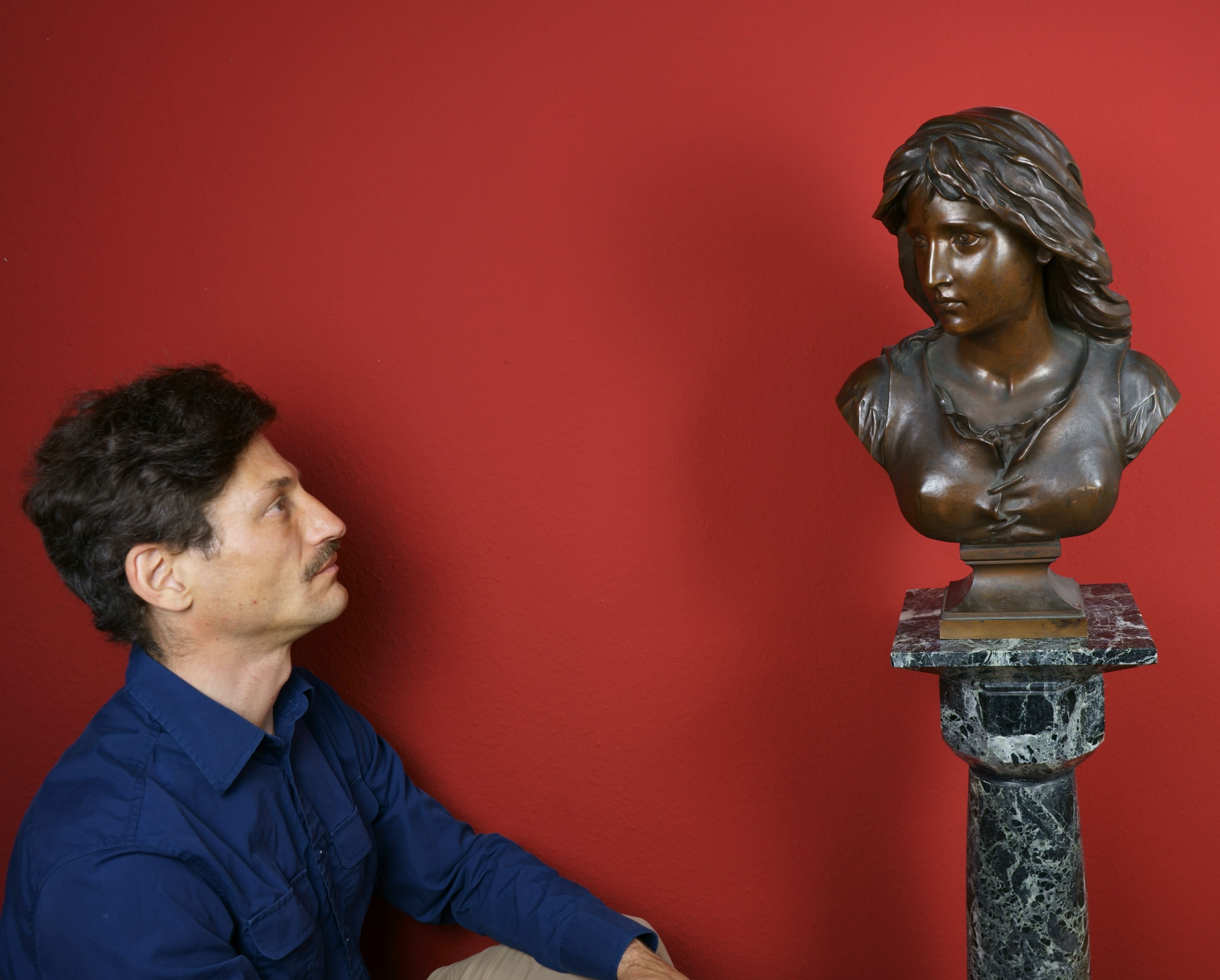
About the Seller
5.0
Vetted Professional Seller
Every seller passes strict standards for authenticity and reliability
Established in 2014
1stDibs seller since 2023
22 sales on 1stDibs
- ShippingRetrieving quote...Shipping from: Berlin, Germany
- Return Policy
More From This Seller
View AllSpear Fighter / - The Fighter's Concentration -
Located in Berlin, DE
Ludwig Eisenberger (active in Berlin between 1895-1920), Spear Fighter, around 1910. Brown patinated bronze with residual gilding on a cast terrain plinth with marble base (8 cm high...
Category
1910s Realist Nude Sculptures
Materials
Bronze
$3,571 Sale Price
20% Off
The Blacksmith of Solingen / - The Double-edged Sword -
Located in Berlin, DE
Wilhelm Albermann (1835 Werden an der Ruhr - 1913 Cologne), The Blacksmith of Solingen, after 1895. Bronze-color patinated zinc cast on plinth, 47 cm (height) x 20 cm (width) x 16 cm (depth), weight 5.5 kg. Signed “Albermann.” on the plinth and identified as a cast by “AKT.[TIEN] GES.[ELLSCHAFT] GLADENBECK BERLIN”. Dedication on the front: “Mr. Ing. F. Kuhlmann to the wedding. Management and officials of the Hannoversche Waggonfabrik. Aircraft construction department".
- The zinc showing through in spots, the patina somewhat stained, the right upper arm under the sleeve retouched in black.
- The Double-edged Sword -
The figure is a reduction of Wilhelm Albermann's 1895 fountain figure of the armourer of Solingen, who has always been identified with the historical blacksmith Peter Hahn. In 1839, Karl Simrock wrote the poem “The Blacksmith of Solingen" and thus coined the legendary figure. The first and penultimate verses read:
A blacksmith spoke to Solingen
With every bayonet,
That came to his diligence:
"Oh, that Fritz had it!"
The war took its course,
Many battles were fought,
Which often made him fearful and anxious
In his soul.
The blacksmith had given up his trade to fight for Frederick the Great. Not least because of his strength and will to fight, the battles were won. With his fountain sculpture, Albermann has given the legendary blacksmith a figurative form and at the same time created a landmark for the city of Solingen, which was once famous for the art of sword forging and today still stands for the production of high-quality knives. During the bombing raid in November 1944, the fountain was destroyed along with the entire old town of Solingen. Only the head remained.
The broad-shouldered blacksmith stands securely behind his anvil, his leather apron tied around him, and has just finished a sword blade with his own "weapon" - the blacksmith's hammer. His entire body shows the strength with which he wields the hammer, but also the strain of this activity, as evidenced by the wide open shirt, the somewhat 'untidy' apron, and especially the furrowed face.
However, the blacksmith does not look at the finished work, but resolutely and at the same time thoughtfully into the distance, in line with the quoted verse from Simrock's poem that the battles "often made him fearful and anxious in his soul". There is certainly something melancholy in his gaze, fed by the knowledge of the necessity of forging swords and taking up arms and their deadly use - experiences Albermann had to make during his own war missions. The flowing full beard gives his gaze into the distance an almost prophetic character.
In keeping with the craft of the perfectly formed art of blacksmithing, the detailed casting reproduces the respective materials depicted in perfect form: the leather apron convincingly conveys the impression of leather and lies - also in the back view - like a second formed layer over the body, while the shirt and trousers illustrate their own textile qualities.
Due to its masterful execution and profound content, the “Blacksmith of Solingen”, which has survived in its cast reproductions, remains Albermann's most famous work to this day.
About the artist
The son of a carpenter, Wilhelm Albermann began an apprenticeship as a joiner, but then followed his artistic calling and trained as a sculptor in Elberfeld. In 1855, at the age of twenty, he was drafted into the army in Berlin, where he served until 1857. Albermann attended the Berlin Art Academy on the side and began regular studies after his service. While still a student, he completed commissioned works for his teachers August Fischer and Hugo Hagen. His first independent commissions followed, enabling him to establish a flourishing sculpture studio in Cologne in 1865. His artistic activities were repeatedly interrupted by military service, and he took part in the German-Danish War in 1864, the war against Austria in 1866, and the Franco-Prussian War in 1870/71. After his last war service, Albermann, already a respected artist, founded a commercial drawing school at the request of the city government, where he taught the modeling class and served as director until 1896. In 1890 he also worked for the "Society for the Promotion of Sculpture in the Rhineland and Westphalia".
Albermann was one of the most prolific sculptors in Cologne in the second half of the 19th century. He created numerous monuments, fountains, tomb sculptures, architectural ornaments, and domestic statues. At its peak, his workshop employed up to thirty sculptors and stonemasons at a time.
GERMAN VERSION
Wilhelm Albermann (1835 Werden an der Ruhr - 1913 Köln), Der Schmied von Solingen, nach 1895. Bronzefarben patinierter Zinkguss auf gegossener Plinthe, 47 cm (Höhe) x 20 cm (Breite) x 16 cm (Tiefe), Gewicht 5,5 kg. Auf der Plinthe mit „Albermann.“ signiert und als Guss der „AKT.[TIEN] GES.[ELLSCHAFT] GLADENBECK BERLIN“ ausgewiesen. Schauseitige Widmung: „Herrn Ing. F. Kuhlmann zur Vermählung. Direktion und Beamte der Hannoverschen Waggonfabrik. Abt. Flugzeugbau“.
- Punktuelles Durchscheinen des Zinks, Patina etwas fleckig, der rechte Oberarm unter dem Ärmel schwarz retuschiert.
- Die Zweischneidigkeit des Schwertes -
Die Figur ist eine Reduktion von Wilhelm Albermanns 1895 geschaffener Brunnenfigur des Waffenschmieds von Solingen, der seit jeher mit dem historischen Schmied Peter Hahn identifiziert wurde. 1839 hatte Karl Simrock das Gedicht „Der Schmied von Solingen“ verfasst und damit die legendäre Figur geprägt. Die erste und die vorletzte Strophe lauten:
Zu Solingen sprach ein Schmied
Bei jedem Bajonette,
Das seinem Fleiß geriet:
»Ach, daß der Fritz es hätte!«
Der Krieg ging seinen Gang,
Man schlug noch viele Schlachten,
Die oft ihm angst und bang'
In seiner Seele machten.
Der Schmied hatte sein Handwerk ruhen lassen, um selbst für Friedrich den Großen zu kämpfen. Nicht zuletzt durch seine Kraft und seinen Kampfeswillen verliefen die Schlachten siegreich. Dem legendären Schmied verlieht Albermann mit seiner Brunnenskulptur eine bildliche Gestalt und schuf damit zugleich ein Wahrzeichen der Stadt Solingen, die einst für die Kunst des Schwerterschmiedens berühmt war und bis heute für die Herstellung qualitätvoller Messer einsteht. Beim Bombenangriff im November 1944 wurde mit der gesamten Solinger Altstadt auch der Brunnen zerstört. Einzig der Kopf blieb erhalten.
Mit sicherem Stand und umgebundener Lederschürze steht der breitschultrige Schmied hinter seinem Amboss und hat gerade mit seiner eigenen ‚Waffe‘ – dem Schmiedehammer – eine Schwertklinge fertiggestellt. Seinem gesamten Körper ist die Kraft abzulesen, mit der er den Hammer führt, aber auch die Anstrengung dieser Tätigkeit, wovon das weit geöffnete Hemd, die etwas ‚unordentlich‘ arrangierte Schürze und vor allem das zerfurchte Gesicht zeugen.
Der Schmied schaut aber nicht auf das vollendete Werk, sondern entschlossen und zugleich sinnierend in die Ferne, entsprechend der zitierten Zeile von Simrocks Gedicht, dass die Schlachten „oft ihm angst und bang‘ in seiner Seele machten“. Der Blick hat durchaus etwas Melancholisches, dass sich aus dem Wissen um die Notwendigkeit, Schwerter zu schmieden und zu den Waffen zu greifen und deren tödlichem Einsatz speist – Erfahrungen, die Albermann bei seinen eigenen Kriegseinsätze machen musste. Der wallende Vollbart verleiht dem in die Ferne schauenden Blick einen beinahe prophetischen Charakter.
Dem Handwerk der formvollendenden Schmiedekunst entsprechend, gibt der detaillierte Guss die jeweils dargestellten Materialien in vollendeter Ausformung wieder: Die Lederschürze vermittelt überzeugend den Eindruck des Leders und liegt – auch in der Rückenansicht – wie eine zweite ausgeformte Schicht über dem Körper, während das Hemd und die Hose...
Category
1890s Realist Figurative Sculptures
Materials
Metal
$1,315 Sale Price
20% Off
Pecheur / - Full of anticipation -
Located in Berlin, DE
Adolphe Jean Lavergne (1863-1928), Pecheur, c. 1900. Brown patinated bronze with rectangular cast plinth on a green marble base (3 cm high), total height with hinge 37 cm, width 9 cm, depth 8 cm, weight 2.9 kg, signed “Lavergne” on the plinth.
- Base with old drilling and a few oxidized areas, patina occasionally rubbed, somewhat stained in the folds.
- Full of anticipation -
This bronze is the larger, highly detailed version of the fisherman that made Parisian artist Adolphe Jean Lavergne famous. In preparation for fishing, the boy prepares his rod before heading out to sea. The attachment of the iron ring and the rope behind him suggest a quay wall and a boat moored there. However, the depiction is entirely focused on the actual action of the young fisherman: With equal skill and concentration, he bends a hook to connect it to the fishing line. The contrast with his casual clothing, the loose-fitting trousers, the open shirt with its "wild" folds, and, last but not least, the sun hat boldly perched on his neck, reinforces the impression of the attentive care with which he goes about his work. His gaze makes him appear absorbed, as if he has forgotten the world around him and yet he is visibly filled with anticipation of fishing.
GERMAN VERSION
Adolphe Jean Lavergne (1863-1928), Pecheur, um 1890. Braun patinierte Bronze mit rechteckiger gegossener Plinthe auf grünem Marmorsockel (3 cm Höhe), Gesamthöhe mit Angel 37 cm, Breite 9 cm, Tiefe 8 cm, Gewicht 2,9 kg, auf der Plinthe mit „Lavergne“ signiert.
- Sockel mit alter Bohrung und wenigen oxidierten Stellen, Patina mitunter berieben, in den Falten vereinzelt etwas fleckig.
- Voller Vorfreude -
Die Bronzefigur ist die größere äußerst detaillierte Ausführung des Fischers, mit dem der Pariser Künstler Adolphe Jean Lavergne bekannt geworden ist. In Vorbereitung auf das Fischen präpariert der Junge die Angel...
Category
1890s Realist Figurative Sculptures
Materials
Bronze
$676 Sale Price
20% Off
Javelin thrower / - Roman present -
By Franz Iffland
Located in Berlin, DE
Franz Iffland (1862 Tempelhof - 1935 Berlin), Javelin thrower, after 1910. Olive-black patinated bronze with cast plinth mounted on a white-veined black marble base (7 cm high). Tota...
Category
1910s Art Deco Nude Sculptures
Materials
Bronze
$2,349 Sale Price
20% Off
The Fieldman and Death / - Sowing and Harvest -
Located in Berlin, DE
Rudolf Nehmer (1912 Bobersberg - 1983 Dresden), The Fieldman and Death, around 1948. Woodcut on yellowish wove paper, 16.8 cm x 15.8 cm (depiction), 42 cm x 30 cm (sheet size), signe...
Category
1940s Realist Figurative Prints
Materials
Woodcut
$225 Sale Price
20% Off
The Victorious David / - The melancholy of the radiant hero -
Located in Berlin, DE
Henri Honoré Plé (1853 Paris - 1922 Paris), The Victorious David, around1890. Red-brown and brown patinated bronze with terrain plinth mounted on a round base. 42 cm (total height) x...
Category
1890s Realist Figurative Sculptures
Materials
Bronze
$1,785 Sale Price
20% Off
You May Also Like
Gaston Schweitzer : "Potatoes picker ", original plaster -1958
By Gaston Schweitzer
Located in SAINT-OUEN-SUR-SEINE, FR
Gaston SCHWEITZER (1879-1962? France): "Potato picker"
Original plaster with medium "ground colour" patina
Unique piece
Signed with artist monogram on base
Dated "6.58" (June 1958...
Category
Vintage 1950s French Modern Figurative Sculptures
Materials
Plaster
Hay Picker
By Aimé-Jules Dalou
Located in PARIS, FR
This Peasant resting is a subject that is included in the famous suite commonly called "little workers" by Jules Dalou (1838-1902)
Bronze with nuanced dark brown patina
cast by Susse Frères - stamped with the founder's seal
France
created around 1890 and cast after his death
height 12,5 cm
A similar model reproduced inJules Dalou, le sculpteur de la République, Exhibition held at the Musée du Petit Palais, Paris, 2013, page 288, n°220.
Biography :
Aimé-Jules Dalou, said Jules Dalou (1838-1902) was a French sculptor, born from Protestants glovers craftsmen who raised in secularism and love of the Republic. Jules Dalou was very young talented for modeling and drawing, which earned him the attention of Jean-Baptiste Carpeaux, who made him entered in 1852 in the Little School, the future National School of Decorative Arts in Paris. In 1854, he was admitted to the School of Fine Arts in Paris, where he studied painting in the workshop of Abel de Pujol and sculpture in the workshop of Francisque Duret...
Category
Late 19th Century French School Figurative Sculptures
Materials
Bronze
Locomotive Engineer, Early 20th Century Bronze Laborer, Cleveland School
By Max Kalish
Located in Beachwood, OH
Max Kalish (American, 1891-1945)
Locomotive Engineer, 1926
Bronze
Signed and dated on base, foundry mark: Meroni Radice Cire Perdue Paris
15.5 x 6 x 5 inches
Born in Poland March 1, 1891, figurative sculptor Max Kalish came to the United States in 1894, his family settling in Ohio. A talented youth, Kalish enrolled at the Cleveland Institute of Art as a fifteen-year-old, receiving a first-place award for modeling the figure during studies with Herman Matzen. Kalish went to New York City following graduation, studying with Isidore Konti and Herbert Adams...
Category
1920s Figurative Sculptures
Materials
Bronze
Harvest Scene With Farmer and Scythe, 1886
Located in Stockholm, SE
"Harvest Scene With Farmer and Scythe, 1886" is a captivating painting by the Swedish artist Alfred Thörne. Created during his travels through Germany, France, Italy, and Belgium bet...
Category
1880s Romantic Figurative Paintings
Materials
Canvas, Oil
The Fisherwoman, 19th century French bronze sculpture
By Émile Louis Picault
Located in Beachwood, OH
Émile Louis Picault (French, 1833-1915)
Fisherwoman
Bronze
Stamped "E. Picault"
30 x 15 x 12 inches
Subject depicting a young woman holding fishing line in one hand a basket of fis...
Category
19th Century Figurative Sculptures
Materials
Bronze
Old Soldier
Located in New York, NY
Humphris is a highly acclaimed American sculptor and created a large body of work of Western subject matter, particularly of the American Indian so rare to get a soldier. He did liv...
Category
1910s American Realist Figurative Sculptures
Materials
Bronze

